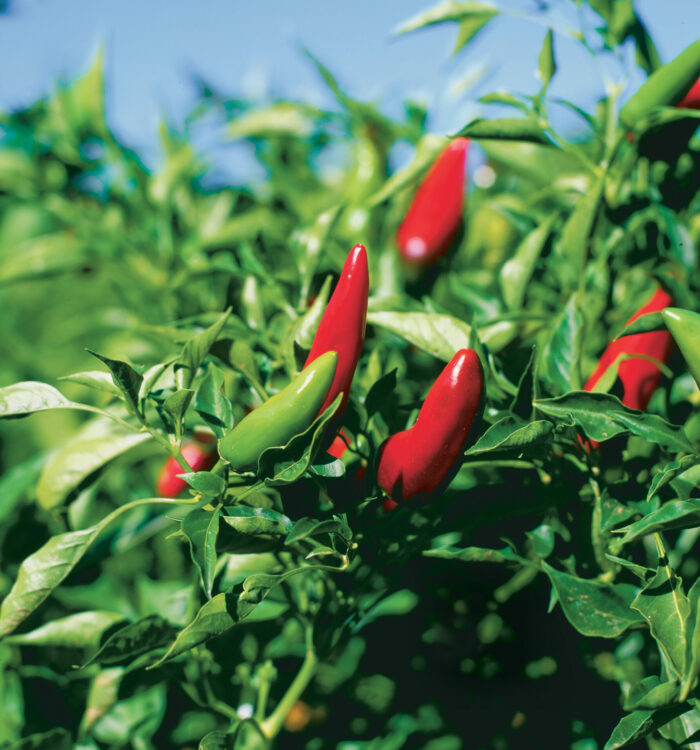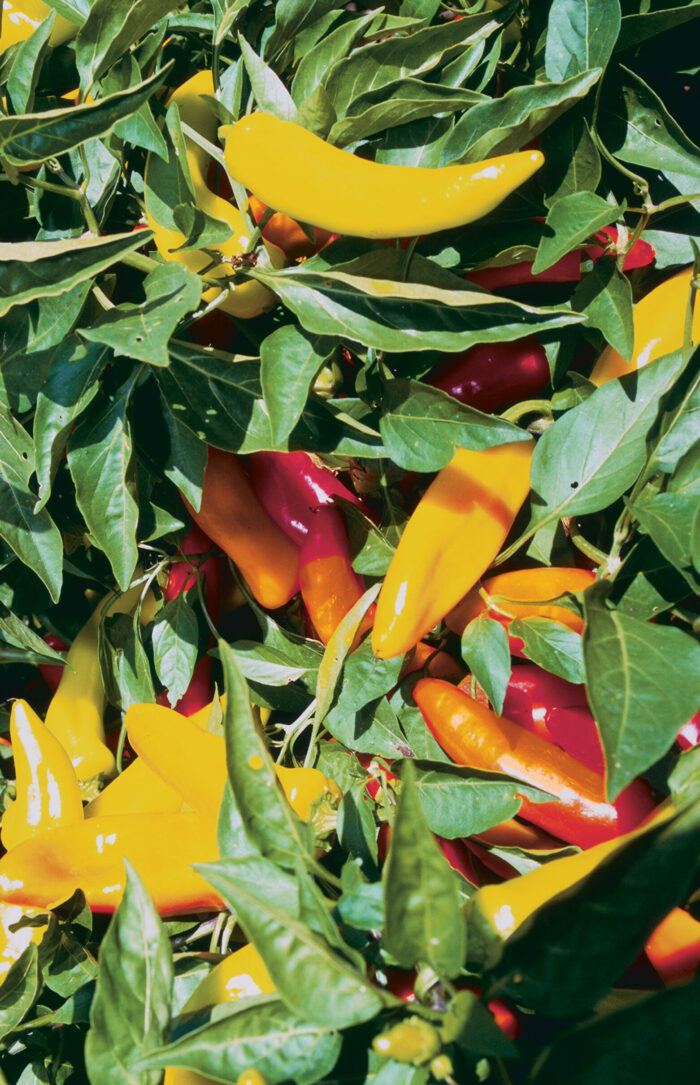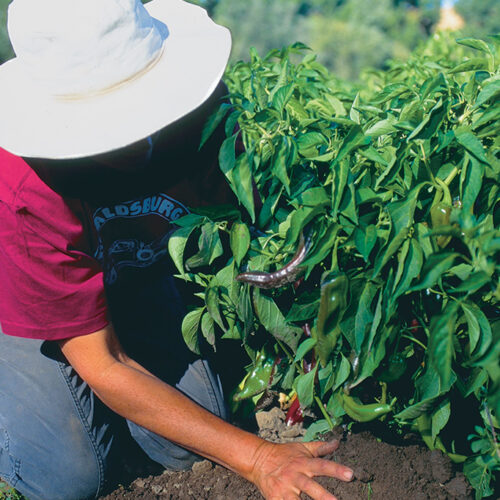Growing Chile Peppers for Those Who Like It Hot
Some are mild, others can burn you alive, but they all need heat to really thrive

Until recently, if you wanted to add a little fire to your food, you didn’t have many choices. You could grind black peppercorns over your plate or shake on some dried red chile flakes. If you were really adventurous, you could give your food a couple of squirts of Tabasco sauce. But the pickings were pretty slim.
Lately, however, the whole topic of spicy foods has gotten hotter than a habanero. Authentic Mexican food, Thai cuisine, and Hunan dishes are all the rage—and they all use some type of chile for their heat. Consequently, you’ll find that most supermarkets have a variety of hot chile sauces on their shelves and lots of fresh chiles in their produce sections. The sudden popularity of chile peppers is good news for the vegetable gardener: Almost every seed catalog you open now lists lots of hot chile varieties.
You’ve probably heard that variety is the spice of life. We’ll take that a step further and say that growing a variety of chiles will add a whole lot of spice to your life, your kitchen, and your garden. It takes a little work—you’ll need a seed-germinating heat mat and you’ll have to transplant the seedlings twice—but you’ll be rewarded with a colorful and flavorful abundance of different chiles.
Warm it up
- Start chile seeds in flats eight weeks before you want to transplant them outside.
- Set flats on a germinating heat mat set to 80°F.
- When seeds sprout, place a fluorescent light directly over the seedlings, almost touching them.
- After four weeks, transplant them to small pots and keep them warm.
- After four more weeks, harden them off and plant outside when the garden soil is warm.
- Stake plants to prevent tipping.
- Harvest chiles as they mature to encourage the plants to continue to flower.
Pick your pepper based on your heat tolerance
Not all chile types are excruciatingly hot. Some are quite mild and will make your tongue tingle only a little bit. And don’t confuse the hotness of a chile with its taste. Taste and heat are two separate sensations, and all chiles have both.
New Mexican chiles are only mildly hot. If you peruse seed catalogs, you’ll see that New Mexican, Anaheim, or long green and red chiles are all the same type. Call them what you will, all varieties of this type of chile have productive, 12- to 20-inch-tall plants. Some pods hang down, while others, known as mirasol, point straight up. Expect up to 75 pods per plant. New Mexican chiles are used fresh as green chiles, but when they ripen red, they get sweeter and hotter.

Poblanos are large, mild-tasting chiles that are excellent in chile rellenos—whole chiles stuffed and fried in a fluffy egg batter. The plants are not particularly productive; even the new, improved varieties often grow fewer than 10 pods per plant. Poblanos have thin walls, making them perfect for drying. After they ripen, having turned from dark green to bright red, you can string the chiles together and hang them in the sun or other dry place, then use them throughout the year. When they are dried, poblanos are called anchos.
Hungarian wax chiles (photo right) are bright yellow, and they have a mild flavor that is more like a sweet pepper than a hot chile. There are medium-hot and hot varieties. The plants are very productive, and they set pods early, making them good for northern gardens. Most will ripen to luscious reds and oranges that are deliciously sweet.
Cayennes, both red and gold, are best for adding just-plain heat to anything. The plants are small, but they produce plenty of chiles that ripen early. One or two small plants will provide enough for the year. Their thin skins make them excellent drying chiles.
Jalapeños are probably the best middle-of-the-road chiles because they’re not too hot and not too mild. These are the chiles most people imagine when they think of hot peppers. Jalapeños are the standard salsa chile and the canned pepper you see in the Mexican-food section of your supermarket. All jalapeño varieties are productive, growing around 75 pods per plant. Jalapeños can be used green or when they ripen to a bright red color.
Serranos are little finger-size bullets of heat. They can be used green, but we think they are best in salsas, sauces, stews, and soups after they ripen to a bright red. The plants are tall and wide, growing up to 3 feet in both directions. Serranos produce pods much later than jalapeños, but when they do, the plants are absolutely loaded.
Most people say habaneros are the hottest type of chile in the world. Many habanero chiles have small squarish pods with lots of folds and crevices. One catalog describes its ‘Golden Habanero’ as “positively NUCLEAR.” Of all the habaneros, the Scotch bonnet is our favorite small, fiery chile for spicy Asian stir-fries, curry dishes, salsas, and marinades; it still has some of that wonderful, fruity habanero flavor, but it’s not as hot as some habaneros. The plants are short and wide, and they set a tremendous number of pods, even in a summer that may not have had enough sun or warm weather to produce other habaneros.

Seeds don’t make chiles hot
A pepper’s hotness comes from the capsaicin (cap-SAY-a-sin): the light-colored, pulpy membranes (ribs) inside a chile pod’s walls. Capsaicin is a tasteless, odorless compound that is insoluble in water. That’s why drinking water or chewing on an ice cube won’t kill the burning sensation after you eat a particularly fiery chile. To minimize the release of capsaicin, cut the chile in half, rake out the ribs and seeds, and rinse it well.
Heat is essential for successful seed starting
To start seeds, we spread about 2 inches of a very porous seed-starting mix in a plug tray. Of course, chile seeds need water, but little chile roots can’t stand soggy soil and they need oxygen. Make sure your potting mix provides good drainage and aeration. Sprinkle the seeds thinly on top of the mix, then cover them with half an inch of potting mix.
Put the tray on a germination heat mat and set the thermostat so that the soil stays about 80°F. After the seeds sprout, which can take anywhere from five days to two weeks, they’ll need a lot of light. If you don’t have a greenhouse, place the trays on a windowsill and supplement the natural light with a fluorescent bulb. Keep the lamp almost touching the tops of the plants, raising it as the plants grow.
The two cotyledons, or seed leaves, will open first. At about four weeks, when the next set of leaves opens—the first true leaves—we transplant the seedlings into plastic pots or six-packs. We find the six-packs to be handier because they make the most out of the space available on the heating mat.
Transplanting helps the chiles develop a strong root system. Strong roots can keep a plant from falling over when it’s laden with pods. Adjust the temperature of the heat mat so that the soil stays about 75°F, and keep the lamp right on top of the plants.
Water the seedlings enough to keep the soil evenly moist. Every other watering can be a weak solution—twice the recommended amount of water—of either fish emulsion or a soluble starter fertilizer with low nitrogen (15-25-25). Nitrogen is great for leaf development, but too much nitrogen can hamper the development of the chile plant’s pods.
Stake plants to prevent sunburn
 Chile plants thrive in full sun; in fact, they need full sun so that the pods can ripen. The problem is that the pods can suffer from sunburn, which makes them taste sour. Because chile plants—especially the bigger types, like poblanos—tend to tip over and expose their pods to the hot sun, we stake each plant right after it goes in the ground, then push dirt around it for additional support.
Chile plants thrive in full sun; in fact, they need full sun so that the pods can ripen. The problem is that the pods can suffer from sunburn, which makes them taste sour. Because chile plants—especially the bigger types, like poblanos—tend to tip over and expose their pods to the hot sun, we stake each plant right after it goes in the ground, then push dirt around it for additional support.
Acclimate your chiles to the garden
If you put chiles in the garden too early, they will not do well. Along with warm nighttime temperatures, you also need garden soil that feels warm up to your wrist when you dig your hand into the ground. If you absolutely can’t wait for the weather, you can warm up your soil by covering it with a layer of black plastic.
Hardening off involves gradually decreasing the soil temperature and allowing the soil to dry a little more between each watering. The plants can spend their seventh week outside in their pots if you’re sure that nighttime temperatures are at least 45°F.
If night temperatures are consistently above 55°F, you can transplant the chiles outside at about eight weeks. But if the soil is not warm or the nights are still too cold, you should either protect the plants in the garden with some kind of row cover or keep the plants inside a little while longer, fertilizing the pots lightly.
A sunny garden enriched with compost is ideal for chiles. As before, when you were feeding the newly transplanted seedlings, don’t use any nitrogen-rich organic additives that might inhibit pod production.
To plant a chile, use your hand to scoop out a hole that is just a little deeper than the pots. Then set a transplant in this hole, burying the root ball up to the cotyledons. Fill in the hole, and firm down the soil. Continue to water the transplants with the same fertilizer you were using for the seedlings, and you’ll be harvesting before you know it.
The more you pick, the more you get
You can start picking your chiles when they are mature, before they ripen to their final color. Except for some yellow chiles, like Hungarian wax, mature chiles are green. Look for a full-size pod, and squeeze it gently. It should be heavy and feel thick and hard. Harvesting chiles as they mature encourages the plant to continue flowering. Your overall production will be greater if you keep picking the mature green chiles.
But don’t feel that you need to pick all the pods when they’re full grown. As chiles ripen, their flavor, heat, and beauty increase until the chiles reach their final color of dark green, yellow, orange, or red, depending on the type. When a chile reaches its ripe color, it should be harvested; otherwise, it will dry up and get soft. Chile pods are best harvested using clippers or shears. Pulling the pods can tear the plant.
Lee James and her brother, Wayne, own Tierra Vegetables in Healdsburg, California.
Photos, except where noted: Boyd Hagen














Comments
Log in or create an account to post a comment.
Sign up Log in